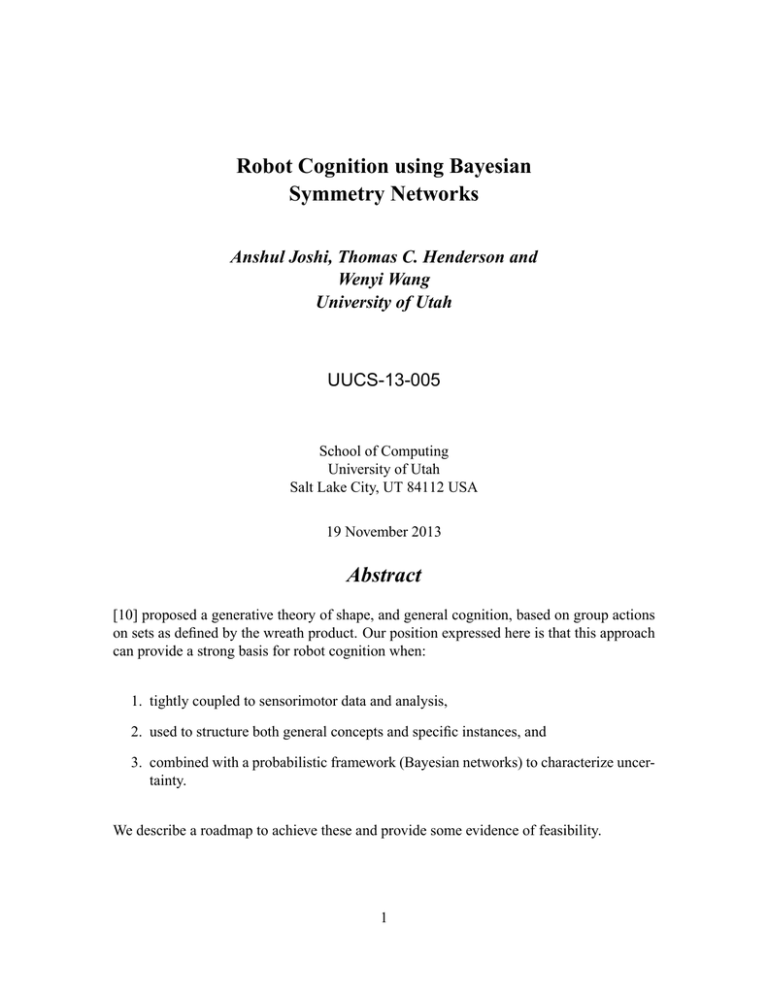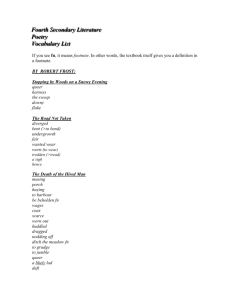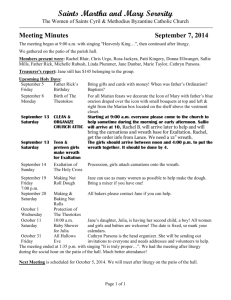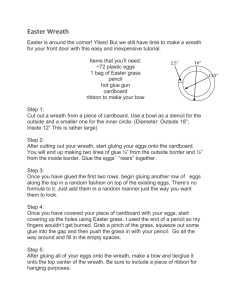Robot Cognition using Bayesian Symmetry Networks Abstract Anshul Joshi, Thomas C. Henderson and
advertisement

Robot Cognition using Bayesian
Symmetry Networks
Anshul Joshi, Thomas C. Henderson and
Wenyi Wang
University of Utah
UUCS-13-005
School of Computing
University of Utah
Salt Lake City, UT 84112 USA
19 November 2013
Abstract
[10] proposed a generative theory of shape, and general cognition, based on group actions
on sets as defined by the wreath product. Our position expressed here is that this approach
can provide a strong basis for robot cognition when:
1. tightly coupled to sensorimotor data and analysis,
2. used to structure both general concepts and specific instances, and
3. combined with a probabilistic framework (Bayesian networks) to characterize uncertainty.
We describe a roadmap to achieve these and provide some evidence of feasibility.
1
1 INTRODUCTION
Our goal is to develop cognitive capabilities for autonomous robot agents. [11] state that
cognition ”can be viewed as a process by which the system achieves robust, adaptive, anticipatory, autonomous behavior, entailing embodied perception and action.” For us, this
includes the ability to:
1. analyze sensorimotor data in order to determine a rational course of action,
2. represent and recognize important concepts describing the world (including its own
self),
3. recognize similarities between concepts,
4. extend concepts to new domains, and
5. determine likelihoods of assertions about the world.
We have previously argued that an effective basis for robot cognition requires some form
of innate knowledge; see [6]. In fact, most current robot implementations rely mostly on
innate knowledge programmed in by the system builder (e.g., sensor data analysis algorithms, object recognition, kinematics and dynamics, planning, navigation, etc.), although
some aspects of the robot’s knowledge may be learned from experience. This approach
to establishing robot cognitive faculties does not scale well, and as a more effective and
efficient paradigm, we have proposed that a collection of symmetry theories form the basic innate knowledge of an autonomous agent [5, 8, 7, 9]. These are defined as formal,
logic-based systems, and then the robot proceeds to use this knowledge by analyzing sensorimotor data to discover models for the theories. For example, the axioms which define
a group require a set of elements and an operator that acts on the set such that the closure,
identity, inverse and associativity properties are satisfied. Figure 1 shows how this works.
Namely, sets and operators are found in the sensorimotor data and checked to see is they
satisfy the axioms. If so, then the robot may use the theory to test new assertions (i.e.,
theorems) that follow from the axioms and have direct meaning for the model, but which
may never have been experienced by the robot.
We propose that in addition to a logical framework to allow assertions about the world,
robot cognition requires a representational mechanism for sensorimotor experience. The
wreath product provides this; for a more detailed account of wreath products, see [2, 4, 10].
The wreath product is a group formed as a splitting extension of its normal subgroup (the
direct product of some group) and a permutation group. As an example, consider the wreath
2
Figure 1: Models for Theories are Discovered: (1) A theory is defined; (2) Sets and Operators are Hypothesized from Sensorimotor Data; (3) Axioms are Validated for Hypotheses;
(4) Theory is Exploited.
product representation of the outline of a square shape: {e}≀Z2 ≀ℜ≀Z4 , where {e} represents
a point, Z2 is the mod 2 group meaning select the point or not, ℜ is the continuous (oneparameter Lie) translation group, Z4 is the cyclic group of order 4, and ≀ is the wreath
product. [Note that: ℜ ≀ Z4 = ℜ × ℜ × ℜ × ℜ ⋊ Z4 where ⋊ is the semi-direct product.]
Leyton [10] describes this representation in great detail and explains the meaning of the
expression as follows:
1. {e}: represents a point. (More precisely, the action of the group consisting of just
the identity acting on a set consisting of a point.)
2. {e} ≀ Z2 : represents the selection of a point or not; i.e., to get a line segment from a
line, just select the points on the line segment by assigning the 1 element to them.
3. {e} ≀ Z2 ≀ ℜ: represents a line segment; i.e., one side of the square.
4. {e} ≀ Z2 ≀ ℜ ≀ Z4 : represents the fact that each side of the square is a rotated version of
the base segment; i.e., the four elements of Z4 represent rotations of 0, 90, 180 and
270 degrees.
Each new group to the right side of the wreath symbol defines a control action on the group
to the left, and thus provides a description of how to generate the shape. E.g., to draw a
3
Figure 2: Control Flow in a Wreath Product gives an Explicit Definition in Terms of Actuation of how to Generate the Shape; e, the group identity (rotate by 0 degrees) acts on
the first copy, ℜ1 to obtain the top of the square; r90 acts on ℜ1 by rotating it 90 degrees
about the center of the square to obtain the right side, ℜ2 ; r180 acts on ℜ1 by rotating it 180
degrees to obtain ℜ3 , and finally, r270 acts on ℜ1 rotating it 270 degrees to obtain ℜ4 .
square, start at the specified point (details of the x,y values of the point, etc. are left to
annotations in the representation), translate some length along a straight line, then rotate
90 degrees and draw the next side, and repeat this two more times. Figure 2 shows how
control flows from the rotation group, Z4 , down to copies of the translation group, ℜ.
Thus, taken together, innate theories allow the discovery of the basic algebraic entities (i.e.,
groups) of the wreath products, and wreath products allow the description of concepts of
interest (here restricted to shape and structure). In the following sections, we expand on
the exploitation of sensorimotor data (actuation is crucial) in operationally defining wreath
products.
Finally, we propose a probabilistic framework for characterizing the uncertainty in wreath
products. The wreath product maps directly onto a Bayesian network (BN) as follows:
1. The rightmost group of the wreath product forms the root node of the BN. Its children
are the direct product group copies to the left of the semi-direct product operator.
2. Recursively find the children of each interior node by treating it as the rightmost
group of the remaining wreath product.
For example, consider the square expressed as {e} ≀ Z2 ≀ ℜ ≀ Z4 . Figure 3 shows the corresponding BN.
4
Figure 3: Bayesian Network for the Wreath Product of a Square Created by Rotation.
[Note that the continuous translation group ℜ calls for an uncountable number of cross
product groups (one for each real), but we do not implement this explicitly.] The following
sections describe how the conditional probability tables can be determined from frequencies encountered in the world (e.g., the likelihood of squares versus other shapes), and
experience with the sensors and actuators (e.g., the likelihood of the detection of the edge
of a square given that the square is present in the scene). [1] proposed a Bayesian network
approach for object recognition based on generalized cylinders, but our method differs in
that we use the more general wreath product representation (which can represent generalized cylinders) and include actuation in the description, and we derive the BN’s from the
wreath product; also see [12].
2 ROBOT CONCEPT FORMATION
We now describe an architecture to allow object representations to be constructed from
groups discovered in sensorimotor data, and combined to form wreath products. Figure 4
gives a high-level view of the interaction of innate knowledge and sensorimotor data to
produce derived knowledge. A lower level architecture is given in Figure 5 involving longterm memory, short-term memory, behavior selection and sensorimotor data. Cognition
can be driven by the data (bottom-up) or by a template presented in the behavior selection
unit (top-down). In the former case, symmetries are detected in the data which gives rise
5
Figure 4: High-Level Cognitive Process.
to the assertion of groups. Then the structure of these groups is determined to form wreath
products.
Figure 5: Lower Level Layout of Cognitive Process.
Suppose that data from a single object (a square) is to be analyzed. Figure 6 shows a
number of group elements that can be discovered by symmetry detectors applied to image
data of a square; this includes translation, reflection and rotation symmetries; we have
described symmetry detectors for 1D, 2D and 3D data elsewhere [8, 7, 9]. The symmetry
groups would allow the synthesis of ℜ ≀ D4 (this is the same as ℜ × ℜ × ℜ × ℜ ⋊ D4 ) as
6
Figure 6: Symmetry Detection in Image of a Square.
a representation of the data. On the other hand if the drawing of the square were observed,
and it was done by starting with the top most edge and drawing clockwise around the
square, then ℜ ≀ Z4 would be generated. If first the top edge were drawn, then the bottom
edge, then the right, then the left, this would give rise to: Z2 ≀ Z2 Actuation used to observe
the data can also be used to determine the appropriate wreath product; e.g., if motors move
the camera so that the center of the image follows the contour of the square, then this
gives rise to a symmetry in the angles followed (one angle ranges from 0 to 2π, while the
other follows a periodic trajectory. [Also, note that all these wreath products could have a
pre-fixed {e} ≀ Z2 which represents selecting the points on the line segment.]
Next consider the 3D cube. Just like the square, there are several wreath product representations, each corresponding to a distinct generative process. Actual 3D data (e.g., from
a Kinect), will most likely come from viewing one face of the cube or three faces.; Figure 7 shows an example Kinect image for these two situations in the case of a cube-shaped
footstool. For the 3-face view, each visible face has a corresponding hidden parallel face
which can be viewed as either generated from the visible face by reflection or rotation.
The Z2 group represents either of these (in the specific encoding, we choose reflection).
Figure 8(a)(Top) shows the cube viewed along a diagonal axis through two corners of the
cube, and the Z3 rotational symmetry can be seen; i.e., a rotation of 120 degrees about the
axis (K in Figure 8(a)(Bottom)) sends each pair of parallel faces into another pair. The
wreath product for this is then ℜ2 ≀ Z2 ≀ Z3 while the tree structure shown in Figure 8(b)
gives the control action tree.
7
Figure 7: (a) One Face View RGB (b) One Face View Depth Map (c) Three Face View
RGB (d) Three Face View Depth Map
Figure 8: (a) View of Cube along Diagonal Axis with Z3 Symmetries (b) the Control Action
Tree for ℜ2 ≀ Z2 ≀ Z3
8
Figure 9: Bayesian Network for Cube.
3 BAYESIAN SYMMETRY NETWORKS
We have already described how the wreath product provides a nested description of an
object which maps in a natural way onto a causal graph structure for a Bayesian network.
As a working example, we continue with the cube as described in Figure 8(b) for which the
corresponding Bayesian network1 is shown in Figure 9. The graph structure is defined by
the wreath product, and the conditional probability tables are determined by considering
the context (indoors), the sensor data noise, and the algorithm error. The top-most node
Z3 has a prior of 5% true, since this condition holds for normals of any right-angle 3faced corner. The Z2 nodes have a probability of 30% if there is no known Z3 symmetry,
otherwise 80%, and the ℜ2 flat face nodes have conditional probability of 70% if no Z2
symmetry is known, otherwise 95%. The figure shows the likelihoods of each symmetry
assertion with no evidence. Figure 10 shows the changes in probabilities for the network
when it is known that 3 faces exist, and that there is a Z3 symmetry for them. Note that the
likelihoods for the unseen parallel faces rise to 91% in this case. This type of information
may not be readily available to a robot without this cognitive structure.
This works reasonably well in practice; Figure 11 shows Kinect data for a cube shape
viewed along a diagonal and surface normals. To determine if the Z3 symmetry exists, we
determine the average normal for each face, then check the symmetry of the three normals
1
This network was constructed using the AgenaRisk software which accompanies [3].
9
Figure 10: Bayesian Network for Cube with Observations Asserted.
Kinect Range Data
Surface Normals (color coded)
Figure 11: Kinect Cube Data, and Surface Normals.
10
1
0.95
1
0.9
0.6
0.4
0.85
Z Axis
Similarity of 3 Normal Directions
0.8
0.2
0
0.8
−0.2
−0.4
0.75
−0.6
1
0.5
0.7
1
0
0.5
−0.5
0.65
0
100
200
300
400
Angle of Rotation about Mean Vector
Y Axis
0
−1
−0.5
X Axis
Figure 12: (a) Similarity of 3 Surface Normals under Rotation about their Mean Vector; (b)
Trajectories of Normal Endpoints under Rotation.
rotated through 2π radians about their mean vector. Figure 12(a) shows the similarity
measure (best match of three original normals with rotated versions of themselves, while
(b) shows the trajectories of the three normal endpoints under the rotation.
4 CONCLUSIONS AND FUTURE WORK
Our position is that wreath product representations of objects provide a very powerful object concept mechanism, especially when combined with deep connections to sensorimotor
data, tied to specific object descriptions, and embedded in a probabilistic inference framework. Current issues include:
• General Concept Representation: Arbitrary objects can be represented by use of
tensor spline groups, as well as shape modification processes as described by Leyton.
Implementation will require careful attention. In addition, Leyton argued that wreath
products could represent any concept; therefore, extensions need to be found for
structural, material properties, social, and other types of relations.
• Combining Sensor and Actuation Data: A detailed characterization of how sensorimotor data is embedded in the wreath product representation is required. There
11
Figure 13: Error Distribution in Plane-Fitting for Kinect Data.
are limitations in what the actuators can achieve compared to what the sensors can
perceive, depending on the robot used and its Degrees of Freedom (DoF). In the cube
example, we mentioned that a robot with a head having 360◦ 3-DoF can actuate the
concepts as motions. Similarly, a robot with a dextrous hand will be able to manipulate the object and be able to map the actuations to the concepts: e.g., in 2D the
robot can draw the square, given the generative concept of a square, while in 3D it
can trace its fingers along the the smooth faces of a cube and infer the object type
based on the Bayesian network for a cube.
On the contrary, a two-wheeled robot with only a range sensor and no movable head
or hands can only move on the ground, and will thus have limitations in relating
actuations directly to concepts (especially 3D shape concepts).
• Prior and Conditional Probabilities: must be determined for the networks. This
requires a rigorous learning process for the statistics of the environment and the sensors. For example, we are studying the error in fitting planes to Kinect data, and first
results indicate that the noise appears Gaussian (see Figure 13).
• Prime Factorization: In the shapes we address, a Bayesian network can be created
in multiple ways for the same shape; e.g., two square representations are ℜ ≀ Z4 and
ℜ≀Z2 ×Z2 ≀Z2 . The equivalence of resulting shape must be made known to the agent
(even thought the generative mechanisms are different); we are exploring whether
subgroups of the largest group generating the shape allow this to be identified.
• Object Coherence and Segmentation: Object segmentation is a major challenge,
12
and object classification processing will be more efficient if related points are segmented early on. We are looking at the use of local symmetries (e.g., color, texture,
material properties, etc.) to achieve this. Moreover, object coherence can be found
from motion of the object; namely, there will be a symmetry in the motion parameters
for all parts of a rigid object which can be learned from experience.
References
[1] Thomas Binford, Tod Levitt, and Wallace Mann. Bayesian Inference in Model-Based
Machine Vision. In Uncertainty in Artificial Intelligence 3 Annual Conference on
Uncertainty in Artificial Intelligence (UAI-87), pages 73–95, Amsterdam, NL, 1987.
Elsevier Science.
[2] W.Y. Chang. Image Processing with Wreath Products. Master’s thesis, Harvey Mudd
College, Claremont, CA, May 2004.
[3] N. Fenton and M. Neil. Risk Assessment and Decision Analysis with Bayesian Networks. CRC Press, Boca Raton, FL, 2013.
[4] R. Foote, G. Mirchandani, D. Rockmore, D. Healy, and T. Olson. A Wreath Product
Group Approach to Signal and Image Processing: Part I – Multiresolution Analysis.
IEEE-T Signal Processing, 48(1):102–132, 2000.
[5] R. Grupen and T.C. Henderson. Apparent Symmetries in Range Data. Pattern Recognition Letters, 7:107–111, 1988.
[6] T.C. Henderson, Y. Fan, A. Alford, E. Grant, and E. Cohen. Innate Theories as a
Basis for Autonomous Mental Development. Technical Report UUCS-09-004, The
University of Utah, October 2009.
[7] T.C. Henderson, Anshul Joshi, and Eddie Grant. From Sensorimotor Data to Concepts: The Role of Symmetry. Technical Report UUCS-12-012, University of Utah,
School of Computing, Salt Lake City, UT, October 2012.
[8] T.C. Henderson, Hongchang Peng, Christopher Sikorski, Nikhil Deshpande, and Eddie Grant. Symmetry: A Basis for Sensorimotor Reconstruction. Technical Report
UUCS-11-011, University of Utah, School of Computing, Salt Lake City, UT, May
2011.
[9] Thomas C. Henderson, Elaine Cohen, Edward Grant, M.T. Draelos, and Nikhil Deshpande. Symmetry as a Basis for Perceptual Fusion. In Proceedings of the IEEE
13
Conference on Multisensor Fusion and Integration for Intelligent Systems, Hamburg,
Germany, 2012.
[10] M. Leyton. A Generative Theory of Shape. Springer, Berlin, 2001.
[11] D. Vernon, G. Metta, and G. Sandini. A Survey of Artificial Cognitive Systems: Implications for the Autonomous Development of Mental Capabilities in Computational
Agents. IEEE Transactions on Evolutionary Computation, 11(2):151–180, 2007.
[12] L. Zhang and Q. Ji. A Bayesian Network Model for Automatic and Interactive Image
Segmentation. IEEE Transactions on Image Processing, 30(9):2582–2593, 2011.
14


